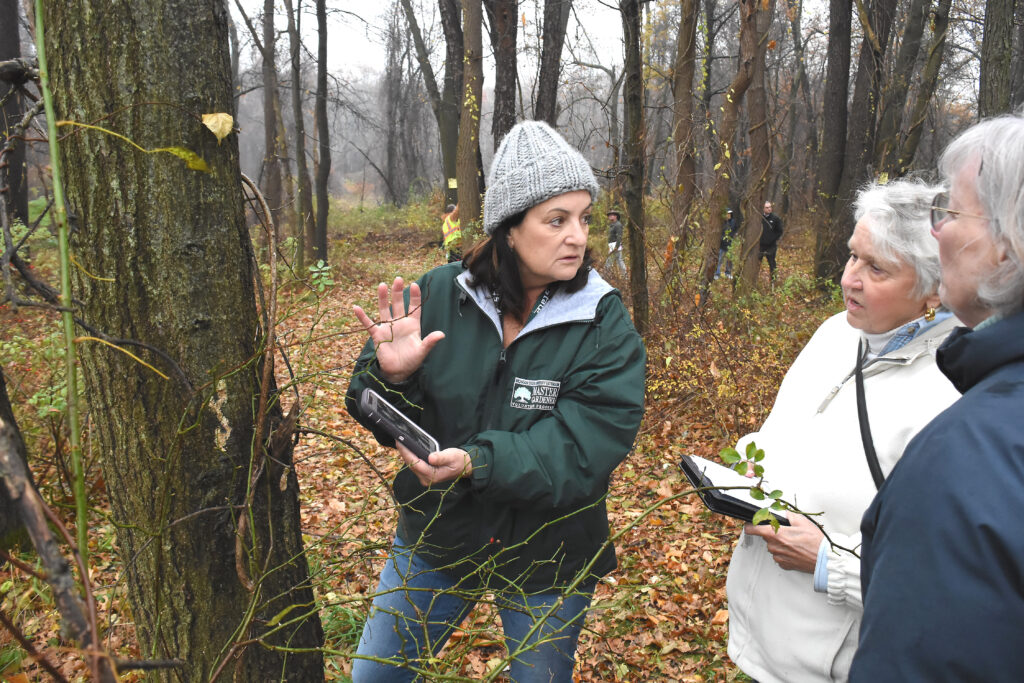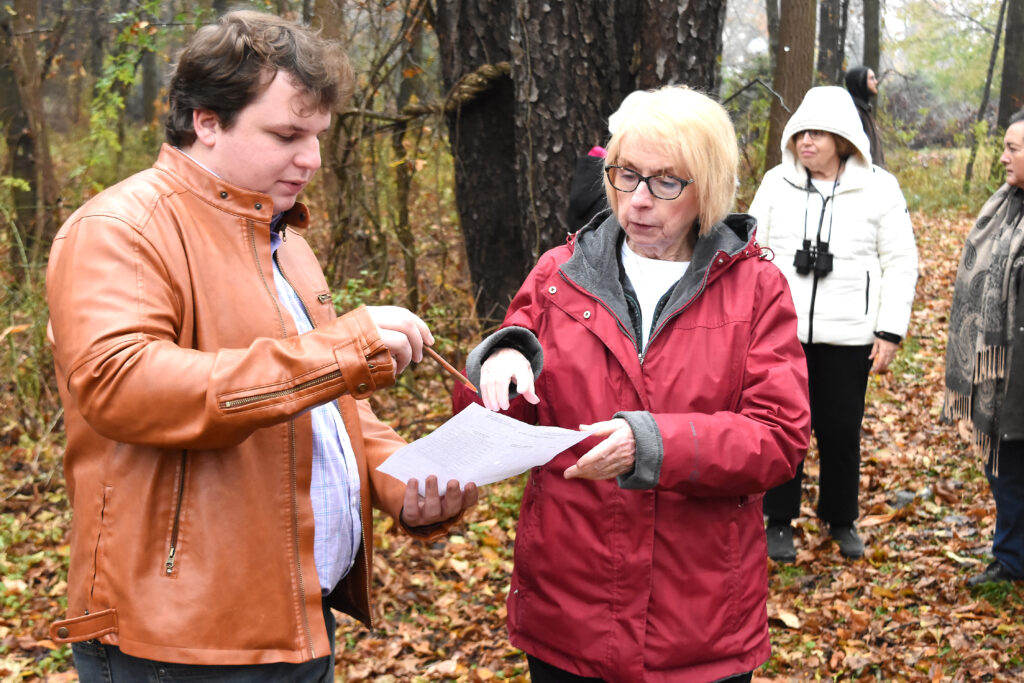
Oxford hosts training on egg mass surveying
By James Hanlon
Leader Staff Writer
The moths were terrible this summer. They devastated tree foliage along Ray Rd., and elsewhere, in Oxford and Addison townships. It was perhaps the worst bout of the invasive insect the area has seen in a quarter century.
Both townships are trying to get ahead of the problem before next year, by surveying the woods for egg masses of Lymantria dispar, formerly known as “gypsy moth.” (This summer, the Entomological Society of America, the scientific organization that oversees common names of insects, stopped using “gypsy moth” because it contains a derogatory term for the Romani people.)
Engaged citizens and staff from municipalities across the county came to Oxford Township Hall, Nov. 17, to participate in training sessions taught by members of the Michigan State University Extension’s Gypsy Moth Program from Macomb County. The four-hour training sessions included both classroom and field activities.

The trainings are part of Oakland County’s new Moth Suppression Program. The county board of commissioners unanimously approved $250,000 for Lymantria dispar mitigation during the 2021 fiscal year budgeting process. The program will provide grants to cities, villages and townships to support their efforts in mitigating the impacts of this invasive species.
Municipalities that wish to apply for the funds must first be trained in surveying. Those that apply for the program will be required to share costs, and a cap on funding will be determined based on interest level. Funding will be awarded on a first-come, first-served basis, and municipalities are required to participate in training before applying for the grants.
“I know that plenty of Oakland County communities are ready to take action to mitigate the impact of these moths,” Minority Caucus Chair Michael Spisz (R-Oxford) said in a statement. “We encourage municipalities to send staff to the training sessions so that they’re eligible for the county funding we’ve made available.”
Terry Gibb, a senior educator with MSU Extension who started Macomb’s Gypsy Moth Program in 1992, led the training in Oxford. “The purpose of the program is suppression,” she said, “because you cannot eradicate it. You’re just not going to. So we have to be smart and responsible with the resources that we have so that we can keep it in that tolerable range without expending all our economic resources.”
The moths hatch sometime in May, as larvae, the caterpillar stage. The creatures feed on tree leaves, especially oak. Large swarms can defoliate entire wooded areas, since there are few native predators to keep them in check. The moths themselves do not kill trees. Rather, they stress the trees, leaving them vulnerable to predators and diseases.
They are also a disgusting nuisance on residential properties.
Spraying
The most effective mitigation is to spray infected trees, from the air, with Bt (Bacillus thuringiensis). The pesticide is a naturally occurring soil bacteria that is completely safe to humans and animals. “If you’ve gardened, played in a sandbox, you’ve come in contact with this,” said Linda Stout, a member of Macomb MSU Extension leadership council who surveyed Oxford Township last year.
Bt only effects the caterpillars at a certain stage of their development because it is only effective when it is ingested. “They have to eat it off the leaves,” Stout said. “It is not a contact killer.”
And “moth” is a bit of misnomer, since only the caterpillars defoliate the trees. As caterpillars, they eat and grow until July, when they form cocoons and pupate for several weeks. They then emerge sometime in August as moths, when they complete the reproductive cycle. But the moths do not eat. “So it doesn’t do any good to spray the moths with Bt,” Gibb said, “because they’re not going to eat.”
Bt cannot be sprayed from the ground. It has to be sprayed from above the treetops where the caterpillars feed.
This year the quoted cost of aerial spraying was $140 an acre. With higher gas prices, it could be even more next year.
A survey of Oxford Township last fall identified 942 acres, in four highly infected areas. At the quoted rate, it would have costed the township $131,880 to spray. (If they sprayed the entire township, it would cost over $3 million.)
But Gibb estimated if Oxford took out the horse farms and golf courses to just focus on residential subdivisions, it would be closer to 500 acres.
“That’s more digestible,” said Rod Charles, an Oxford Township trustee and head of the Gypsy Moth Committee.
The township set aside $150,000 for moth spraying as part of the 2022 budget approved in September, though Township Supervisor Jack Curtis said they might not have to spend that much if they can secure enough matching funds from the county. Some residents might also need to form a special assessment district if they want their subdivision sprayed, depending on the results of the survey and available funding.
Besides the cost, the challenge with aerial spraying is that there is a narrow window of time the Bt is effective. Trees must be sprayed, from low-flying aircraft in mid-to-late May, soon after the caterpillars hatch.
The flight conditions also have to be perfect. It must be early in the morning, with less than 10 mile-per- hour winds, over 40 degrees Fahrenheit, high humidity and no precipitation. They are going to try to coordinate spraying all participating communities in Macomb and Oakland counties in the same day, according to Stout.
Surveying
Because of the costs and tight timeframe, surveying ahead of time is crucial in order to be strategic and precise about what acres need spraying.
The moths begin their life cycle in egg masses ranging from the size of a dime to a quarter, attached to tree trunks and other surfaces. A single egg mass contains anywhere from 50 to 1,500 eggs. “The females that lay the egg masses are opportunists,” Stout said. “They’ll lay them on brick, they’ll lay them behind the eve troughs, on play equipment, on a trailer. Anything that’s parked in your yard. Your lawn furniture, woodpiles, brick piles. Look all those places.”
The masses are laid in mid-August and hatch in mid-May, depending on the temperature. Masses can be surveyed anytime during that range, but it is typically done in late fall when they are easier to spot with less leaves on the trees. It’s also important to get the surveying done early enough so there is enough time to map out the infected areas, identify the exact acreage, start the bid process and line up the funding.
Surveyors will start with data collected from last year’s survey and from residents reporting infestations over the summer. With permission from property owners, they will search for new egg masses. A minimum of eight masses within an 18.5-foot radius forms a “plot.” Two plots, 100 yards apart, form a “spray block” – the smallest area that can be sprayed.
The data collected will be used to create a map of the most infected areas and to plot a potential flight path for the sprayer.
Volunteers save the township money, since it had to pay for the survey last year. “The idea is to become knowledgeable enough to be able to train other people,” Charles said, “because they might not have the training next year. We want people that can do it every year.”
“Exactly,” said Township Clerk Curtis Wright, the other member of the Gypsy Moth Committee. “This year is critical, next year is probably critical, and then you’d be able to assess based upon how effective the program is, assuming we move forward with it this year. I don’t know why we wouldn’t, considering the effort we put in. I think there’s enough momentum now that we see the problem, it’s been identified, we just need to follow through.”
There is plenty of public support, Wright added, it’s just determining the funding that’s holding things up.
Addison Township, meanwhile has over 36 resident volunteers canvassing. According to Deputy Supervisor Jamie Martel, approximately 685 qualifying acres wer found to be infected in Addison Township. The greatest problem areas are on the west side of the township, he said. The data has been submitted to Oakland County’s MSU Extension.
Homeowners who believe they have Lymantria dispar egg masses on their property can contact their townships, or Oakland MSU Extension office at 248-858-0887 and request to be included in the fall survey.


Leave a Reply